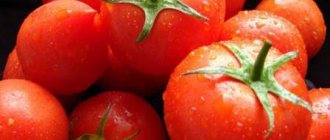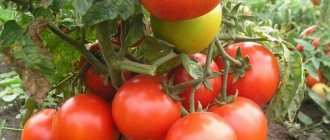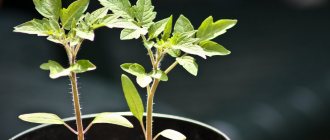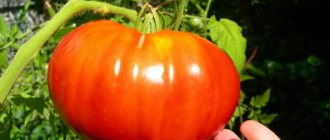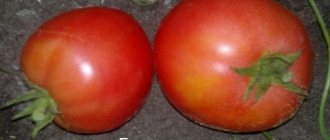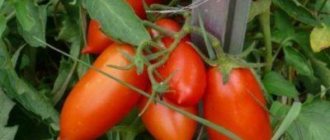Description and characteristics of the variety
Sugar Pudovich tomatoes are meaty and very tasty. Ideal for preparing tomato pastes, juices, ketchups and sauces. For the winter, a variety of canned snacks and lecho are prepared from them. The fruits are quite large, shaped like a ball, only slightly flattened, pink-red in color.
Juiciness is characterized as medium, with a fleshy, grainy center. The bush grows up to 1.5 m if it is grown in a greenhouse. Directly in the garden, the height is slightly less - about 1 m. The fruits grow in clusters, 5-6 pieces on each branch. The plant usually has 5–6 branches. The yield from one bush is from 30 to 35 pieces.
The trunk of the bush usually has two dense stems. The rhizome is small in size, taprooted. The foliage is ordinary, with sharp tips, in light and dark shades of green. The average harvest weight is between 6–8 kg. Novosibirsk scientists selected tomatoes of the Sugar Pudovich variety at the end of the twentieth century and registered them in 1999. The company’s activities are aimed at breeding varieties of various plants that can grow and bear fruit in the cold Siberian climate.
Characteristics and description of the variety with photos
It was bred by qualified breeders specifically for demanding summer residents of any region of the country. The crop can be grown under film, in open beds, in greenhouses
The advantageous difference between Pudovichok and other tomatoes with similar characteristics is that it is not a hybrid. Anyone can select seed from ripe fruits and use it to grow tomatoes without fear of losing their original maternal qualities.
The mid-early culture is indeterminate. The first ripe tomatoes can be tasted 4 months after emergence. In open areas, the bush has a height of 0.8-1 meter, but there have been cases when these dimensions reached 1.5 m. In greenhouse conditions, the dimensions are somewhat different - 1.5-2 m, and sometimes even 2.5 meters.
A large and powerful bush needs a good garter, and constant pinching is also required. Increased branching visually increases the size, and a tomato with a long stem seems simply giant. The color and shape of the tops is similar to potato tops.
The inflorescence of the Sugar Pudovich is unremarkable and differs little from standard brushes. The tomato received its unusual name thanks to its fruits - large, juicy and fleshy. When ripe, they have a slightly flat shape and are red in color.
Each tomato contains 4 seed chambers with a small number of seeds. It is noteworthy that the seeds are easily separated from the pulp, since they lack a protective shell.
The high dry matter content allows tomatoes to be used for making sauces and pastes.
The tomato does not have internal voids, and the flesh itself looks granular and sugary. And the taste matches this quite well. With the most unpretentious care, the weight of the fruit reaches 0.5 kg, and if you follow all care recommendations in a timely manner, tomatoes weighing 1 kg are not at all uncommon.
For all its size and juiciness, Pudovichok is perfectly stored and can be easily transported.
Advantages and disadvantages of the variety
Like all cultivated plants, tomatoes of the variety in question are not without their advantages and disadvantages.
- Advantages:
- tolerate cold weather well;
- plants are not picky about care;
- high productivity;
- large-sized fruits;
- wonderful taste;
- excellent attitude towards transportation;
- versatility of use, can be consumed raw and in the form of preparations.
Did you know? The cultivation of tomatoes began by local Indian tribes in South America about 8-9 thousand years ago.
- Flaws:
- the variety is semi-determinate, which means that the bushes need to be tied up;
- stepsons are formed that need to be removed;
- due to the fact that tomatoes are quite large and heavy, branches can break under their weight;
- in case of improper watering, there may be problems;
- whole tomatoes are not suitable for pickling and pickling;
- weakly resistant to harmful insects and diseases.
Tomato variety “Sugar Pud”: characteristics, pros and cons
It is impossible to imagine a summer cottage without tomatoes. Moreover, every gardener tries to grow several varieties, different in ripening time, purpose, taste, shape and color. The “Sugar Pudovichok” variety does not go unnoticed.
Breeding history
The “Sugar Pudovichok” tomato variety was developed in the 90s of the last century in Russia. The specialists of this company, located in Novosibirsk, are developing varieties for the harsh Siberian climate and northern regions. The variety was registered in 1999.
Tomatoes can be grown both in a greenhouse in the northern regions and in open ground in temperate climates.
Description of the bush
The description of the tomato variety “Sugar Pudovichok” gives the following characteristics of the bush:
- indeterminate;
- height in a greenhouse - up to 1.5 m, in open ground - 80-90 cm;
- the bush is strong;
- the trunk is powerful, most often with two stems;
- requires mandatory gartering and pinching;
- not thickened; the leaves are ordinary, pointed, can be of any green shade (from light green to dark green);
- taproot, small.
Description of the fruit
The fruits of tomatoes of this variety are arranged in clusters. 5-6 fruits are formed on each brush. Although the plant is strong, it is difficult for it to support such weight, so both the stems and fruit clusters are tied up. The fruits themselves are large, round, slightly flattened, red-pink in color. The juiciness is average, without internal voids. Tomatoes have excellent taste. The pulp is fleshy, granular (“sugar”). Weight - maximum 500 g, average - about 200 g.
Maturation period
The variety is considered mid-season. For fruits to ripen from the moment the seedlings emerge, 110-120 days are enough (depending on climatic conditions).
Productivity
The productivity of the “Sugar Pudovich” tomato is high. One bush can have up to 6 fruit clusters, and each of them can have up to 6 fruits. As a result, we get up to 30-36 fruits per plant.
The total weight of the harvested tomato crop is 6-8 kg, and for an experienced gardener - up to 10 kg.
Transportability
Despite the fact that the fruits are large, they tolerate transportation quite well in flat boxes . This way they are arranged in two or three layers and are not subject to compression.
Resistance to environmental conditions and diseases
The tomato is resistant to harsh climatic conditions and temperature changes, because it was bred specifically for cultivation in open ground in central Russia and in greenhouses in the northern regions.
But it cannot be called resistant to diseases and pests. The most common problems may be late blight, tobacco mosaic, and in a greenhouse - brown spot. When growing, it is necessary to disinfect the soil for seedlings, subsequent disinfection of the soil in the beds or in the greenhouse, preventive treatment of the seeds, and then of the bushes.
The most dangerous pests for tomatoes are cutworm caterpillars, wireworms and spider mites . To combat them, you need products purchased in specialized stores.
Application
Tomatoes of the “Sugar Pudovichok” variety have a very pleasant taste. They are suitable for eating raw, for making salads and snacks. For the winter, sauces, ketchups, tomato paste, and canned salads are prepared from them.
Advantages and disadvantages
Like any crop, tomatoes of this variety have a number of advantages and disadvantages.
pros
- Resistance to harsh climatic conditions.
- Easy to care for, the plant is unpretentious.
- High yield.
- Large fruits.
- Excellent taste.
- Handles transportation.
- Versatility in its purpose: raw consumption and processing.
Minuses
- The variety is indeterminate and requires mandatory tying.
- Forms stepsons that need to be removed.
- Stems and fruit clusters may break under the weight of the fruit.
- If improperly watered, fruits may crack.
- Not suitable for whole canning and pickling.
- Unresistant to diseases and pests.
Despite the fact that the “Sugar Pudovik” variety has a number of disadvantages, it is popular because it is completely unpretentious to grow. He will only need garter, weeding, watering and disease prevention. A dozen bushes can feed a whole family with tomatoes, thanks to their high yield. Gardeners love the large, tasty fruits of this tomato.
Basic growing rules
To obtain a rich harvest, you need to adhere to the rules and recommendations of specialists at all stages of the plant growth process. For timely planting, you need to look at the long-term weather forecast and find out when the frosts will stop. By counting down 55–65 days from this date, you can almost accurately determine the day of sowing the seedlings. If you plan to plant in greenhouse conditions, then you can plant the seeds 2-3 weeks earlier.
Growing seedlings
Stage 1. Carrying out antiseptic treatment of seeds and soil.
Seeds purchased in bags at points of sale do not need to be disinfected. However, if these are seeds that you prepared yourself, then they need pre-processing. They may have a fungal, bacterial or viral infection.
To do this, you can make one of the proposed solutions that will kill the infection:
- Potassium permanganate solution 1%, in a proportion of 1 g per 100 ml of water. Place the seeds wrapped in gauze into the prepared solution and leave for 15–20 minutes. It is imperative to note the time; you cannot overdo it. If you wait too long, seed germination may decrease.
- Soda 0.5% solution, in a ratio of 0.5 g of soda per 100 ml of water. Soak the seeds with the prepared solution for a day. Soda solution, in addition to its antiseptic properties, also promotes faster fruiting.
- The drug "Fitosporin". It is offered in liquid and bulk form. Take 1 drop of the liquid preparation and mix it with 100 ml of water. Using the powder, make a solution in the ratio of 0.5 teaspoon of powder per 100 ml of water. Soak the seeds for 1-2 hours.
Various infections can live in the soil, just like in seeds.
Therefore, all soil that is supposed to be used for planting must be treated. There are several such methods:
- Pour the earth onto a baking sheet and fry in the oven for 10–15 minutes at a temperature of +180…+200°C.
- Microwave for 1-2 minutes at 850 W.
- Treatment with boiling water: to do this, place the soil in a container with holes and pour out a small amount of boiling water.
- Pour in a steep solution of potassium permanganate.
Important! The soil that has been disinfected should be moistened and left to “settle” at room temperature for 10–12 days. During this time, the soil will be filled with beneficial organisms that will have a beneficial effect on the planted plants.
Stage 2. Sowing seedlings.
Pour moistened soil into the container, make grooves to a depth of approximately 1 cm, at a distance of 3-4 cm from each other. Place the seeds at approximately a distance of 1–2 cm from each other: the greater the distance between the seeds, the longer the seedlings can be left unplanted. Sprinkle the sown seeds with soil.
The top must be covered with film or glass to ensure a constant microclimate, the humidity in which should be 80–90%. It is best to place the container with sown seedlings near a radiator or heater. For successful germination, seeds need a temperature of +25...+30°C. You need to monitor the condition of the soil daily.
If the soil is dry, it needs to be moistened with a spray bottle, and if high humidity has formed, the soil should be dried by opening the glass. If mold appears as a result of high humidity, you need to carefully remove the top layer, water the soil with a solution of potassium permanganate or use an antifungal drug for watering. This could be Fundazol or Fitosporin.
Depending on the air temperature surrounding the seedlings, the first shoots after sowing will appear in:
- +25…+28°C – 3–4 days;
- +20…+25°C – 5–6 days;
- +10…+12°C – 12–15 days.
Did you know? Swedish naturalist Carl Linnaeus, who gave names to many plants, named tomatoes Solanum lycopersicum, which means wolf peaches.
Stage 3. Proper care.
Tomatoes love light. Therefore, the seedlings need to be placed in the brightest place. If there is little natural light, then additional lighting with fluorescent lamps is recommended. Seedlings love a humid climate. Therefore, seedlings need to be accustomed to normal humidity gradually. You can open the film or glass for short periods of time every day. The crops can be fully opened only after 1–2 weeks.
You need to water carefully, right up to the stem. To do this, it is better to use a pipette or syringe without a needle. The soil should not be wet or dry. The taller the seedlings become, the more water they require. You need to water either in the morning or during the day. To obtain healthy shoots, plants need to be fed with special fertilizers 2-3 weeks after the first shoots appear.
Stage 4. Transplantation.
Picking (transplanting) into a large container is carried out for the first time after the first leaves appear. Plants must be replanted carefully and be sure to do so so that a bunch of soil remains on the roots. The second time the pickling is done 2-3 weeks after the first into an even larger container of at least 0.5 liters.
Find out what you need to do to make tomatoes turn red faster.
Preparing the site for planting
Tomatoes need loose and fertile soil for rich fertility. It must be prepared in the fall. The soil must be dug up and sprinkled with ash - one glass per m². Ash deoxidizes the soil and acts as a mineral fertilizer. The next layer is sawdust, 3–5 cm thick, in order to make the earth lighter and more porous. All soil will settle well until spring.
In spring, feed the soil with potassium and phosphate fertilizers. A mixture of chernozem and peat soil in a 1:1 ratio is suitable for tomatoes. A few days before planting, the soil must be treated with a solution of potassium permanganate.
Technology of planting seedlings
It is recommended to replant tomato bushes into the ground no earlier than March 20–25. It is better to choose a day for this that is not sunny, but cool, cloudy and windless.
Step by step:
- First you need to make holes at a distance of approximately 40–60 cm from each other in one row. Add a quarter of a bucket of compost, 1 cup of wood ash, you can add fertilizer, and a few shovels of soil into the hole, then mix everything.
- Plant in holes, and deepen the stem by 2–3 cm.
- In a watering can you can dilute fertilizer, saturated with microorganisms for better fertility, and water the planted seedlings with it.
- Cover the stem with soil so that there remains a hole for watering.
- Pour plenty of plain water on top and sprinkle with dry soil.
Features of tomato care
Tomatoes, like any other plants, respond well to care. Let's consider the most necessary procedures, by performing which you can get a rich harvest of tomatoes.
Irrigation rates
In dry weather, tomatoes can be watered generously. In normal climates, watering should be carried out every 1–2 days, provided that 6–7 liters of water are poured into each hole.
Important! When the tomatoes grow, the watering rate can be increased.
With the appearance of the first reddened fruits, there is no need to water abundantly to avoid wateriness of the fruits. It is recommended that the water for watering tomatoes is not cold.
Feeding
Tomatoes need additional nutrition. Natural remedies are used for seedlings. For example, a mixture of manure and grass is perfect. You can buy fertilizers based on guano, vermicompost, and humic fertilizers. When feeding seedlings with fertilizers, the dose should be reduced by half from that recommended for a particular product.
Stepping and bush formation
Tomatoes need to be pruned. Cut off the stems that grow above the first branch. It is recommended to tear off the leaves located below the first cluster after the ovary has formed.
Loosening the soil and weeding
Before planting, be sure to dig and loosen the soil. Weeds around the bushes must be weeded out.
Diseases and pests of the Sugar Pudovich variety
Although the variety in question tolerates harsh climates well, it is not resistant to many diseases and pests. The most common enemies of this crop are late blight and tobacco mosaic infection. In greenhouse conditions, tomatoes often suffer from brown spot. Among the insects that harm plants are cutworm caterpillars, spider mites, and wireworms.
To avoid these troubles you need to:
- antiseptic treatment of seeds and soil;
- treatment of bushes with special means aimed at protecting against diseases and pests.
Description of the variety
Tomatoes are resistant to slight low temperatures and tolerate sudden cold weather well. In addition, they are resistant to short-term drought.
Bushes
When grown in open ground, the height of the bush, as a rule, does not exceed 80 cm. In greenhouse conditions, this figure often increases to 120 cm.
When planting, you need to form them into 2 stems. This will ensure stable yields.
Fruit
Tomatoes have large, red, round fruits with slightly flattened sides. Inside they are divided into 3 seed chambers. Typically, the weight of one tomato ranges from 400 to 600 grams.
Productivity
With proper formation of the bush, you can harvest 10 kg from each grown plant. And with a more careful approach to care, all 12 kg.
Application
Compared to other varieties, the fruits of these tomatoes have a denser texture. Because of these features, they are perfect for preparing various salads, as a filling for sandwiches, and as slices for the holiday table.
Heat treatment will only better reveal their amazing taste. Therefore, tomatoes cut into several parts are also used to prepare various marinades.
Harvest and storage
Tomatoes should be harvested when the fruits have just begun to turn brown. In the warmth, they will ripen in a week, and their taste will be no different from tomatoes picked from the bush.
Wooden boxes are best suited for storing tomatoes. Dry, whole, healthy fruits need to be packed tightly into them. Place these boxes in a cool place, preferably non-residential and ventilated. Using this method, tomatoes will last for 2 months. Thus, in order for the beds to delight you with a rich harvest of tomatoes, you need to adhere to the basic rules. Grow with pleasure and enjoy delicious fruits.

